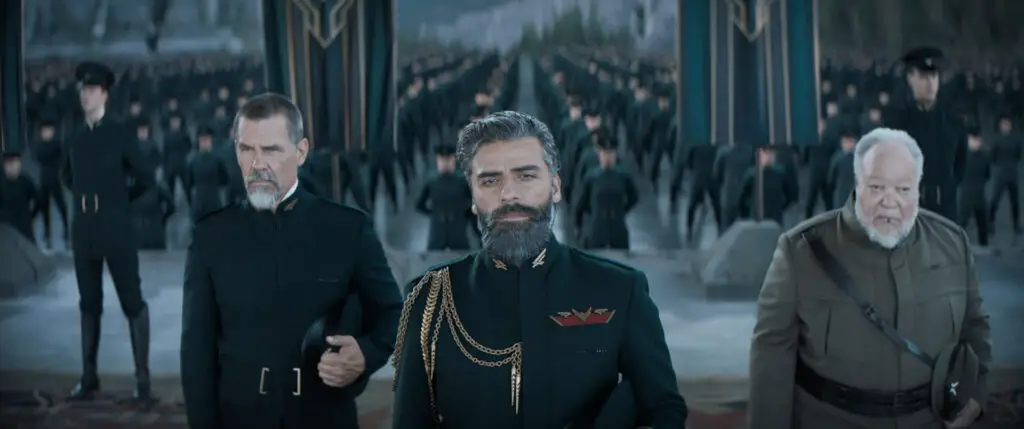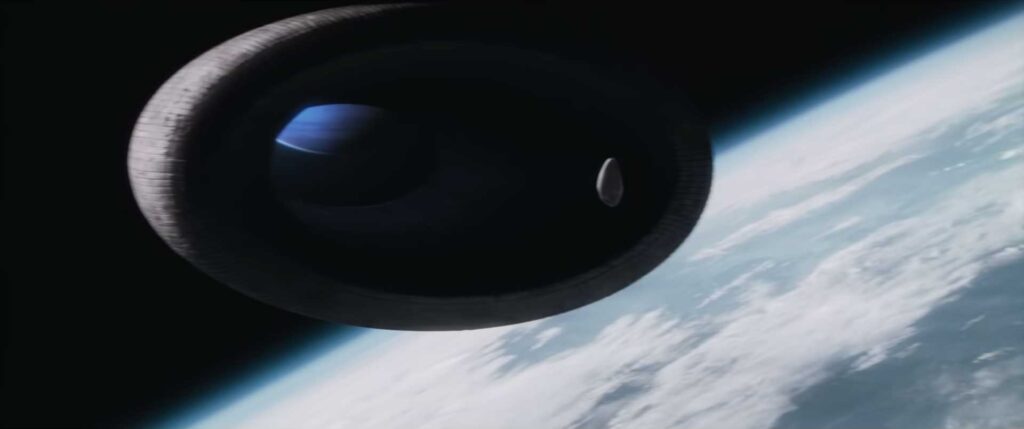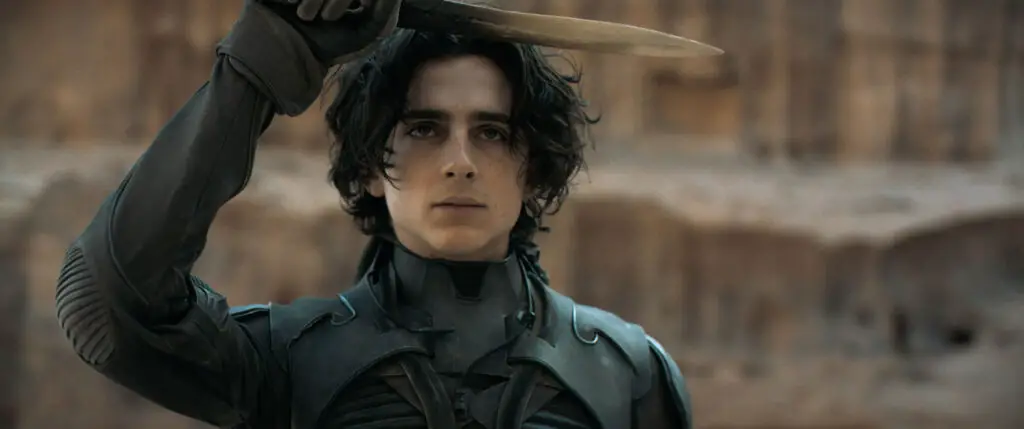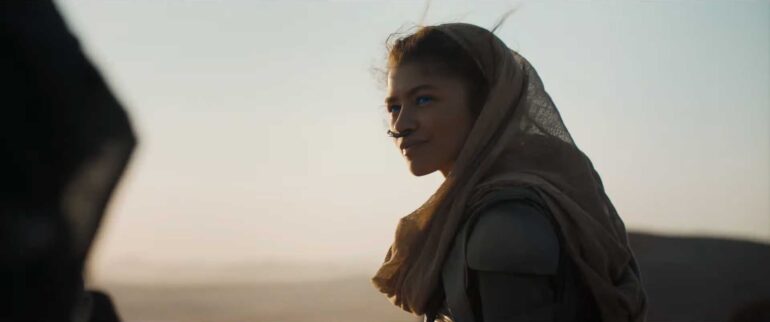Now that Dune: Part One has been widely released in most regions of the world, the veil of secrecy has truly been lifted and waves of behind-the-scenes insights are coming in every day from cast and crew. In an interview on the “Empire Spoiler Special Podcast”, Denis Villeneuve was largely unreserved for this in-depth discussion about events of the first movie and beyond.
The director—who intended from the beginning to adapt Frank Herbert’s original Dune novel into two full-length films—confirmed that the film’s ending is what he had in mind initially and has no doubt it’s the right place to split the story. He revealed, however, that they did explore different options.
My first intuition was to break there. And then we tried also to break it a bit later. Because in the book, there’s a natural moment—there’s like a two-year gap or something like that. But it didn’t work out because it really felt like at the very end of two hours and a half, you were suddenly starting a new story—which is the one of Paul and Jessica being introduced to Fremen culture and being accepted by the Fremen. It was feeling like the beginning of a new chapter, which felt very heavy at the end of the—I’m 100% positively convinced that we stuck at the right moment, where we finally feel that Paul has [gone] from being a boy to an adult, and having all this arc of this first part completed.
Denis Villeneuve, speaking to Empire
Speaking about spoilers, regarding Dune: Part Two premiering in 2023, Villeneuve isn’t overly concerned. “The book has been out there for 60 years,” he quoted his star Timothée Chalamet to emphasize that point, “[and] it’s a very well-known story.” When the interviewer asked about presence of Paul’s mentors in the second part—referring to Duncan Idaho, Gurney Halleck, and Thufir Hawat—the director confirmed that “some” will return. He refrained from details however, for the benefit of those who haven’t read the novel.

We know that Villeneuve has been writing the sequel’s script for some time already and he’s clearly excited about returning to shooting the second movie in 2022.
[Dune: Part Two] will be such a cinematic treat. Making Part One for me was just to [set] the table, you know? And to explain the cultures and the background of all the different planets and civilizations. And then to have that chance, now that everything is set, Part Two will be just an amazing playground. It will be so fun to do.
The director wasn’t evasive when it comes to the previously confirmed appearance of Feyd-Rautha. The heir of House Harkonnen will fight the Atreides Lieutenant Lanville, played by Roger Yuan, in one of the early scenes of the second part. Villeneuve also disclosed that this character will have a major role to play in the story:
Definitely. That’s a choice that I personally brought on. There was enough characters that were introduced in this first part, and it will be more elegant to keep Feyd for Part Two. It will be definitely a very, very important character in the second part.

The discussion also covered the colossal Spacing Guild Heighliners, sole method of transportation across the millions of worlds in the known universe. Since their first appearance in the trailers, there has been speculation as to whether these are actually ships (as per the book) or “stargates”. Villeneuve confirms that they are ships, however leaves further explanation for the second part.
The Heighliners that are used by the Spacing Guild are ships. We went through a long period of design. When we came [up] with that shape, I knew we had the right one. It feels like an echo to the worm, and at the same time it feels like it could be seen as a stargate. It’s like the system that [the Imperium] are using to travel and to bridge space and time is… I like again to not explain it and try to stay in a zone of [the] unknown. I think it’s absolutely beautiful. And that’s where we took a little bit of liberty from the book, where it has a feeling that it could be something that is folding space in a way, that you can see it as almost as a stargate. But I like to keep it [a] mystery right now. It will be more permanent and explained in [Dune: Part Two].
The director also elaborated on members of the Spacing Guild—wearing orange spice-filled helms—that we see as part at the Imperial delegation on Caladan, as well as many other elements where he’s intentionally retained a sense of mystery.
They were Guild representatives. They were not Navigators. We don’t see the Navigators in this first part. That was the one of the challenges of this adaptation—I was trying to keep mystery alive as much as possible. We don’t show the Emperor, we don’t see the Spacing Guild Navigators. There’s a lot of characters that are mentioned or that are in the background that we don’t see right away. I tried to keep all the space-traveling as mysterious as possible, like almost bringing some kind of mysticism or sacred relationship with that part of the movie. Everything involving space is just [evocative] and very mysterious.

Villeneuve affirmed that he started the adaptation with the focus on Paul Atreides. He went on to explain the main character’s background:
Yes. The book is about Paul Atreides, but there are several characters, and we are, in the book, embracing several points of view. My dream was to stay very focused only on Paul, but to sometimes have a glimpse on other characters in order to understand the story. But mainly, we stay with Paul and we focus more specifically on him and his relationship with his mother, Lady Jessica. That for me was at the very heart of the story. And it allowed me also to bring more light on the Bene Gesserit sisters and their movement, and on one of my favorite characters of the book, Lady Jessica.
Paul is a very lonely kid at the beginning. A lonely teenager that has no friends but his mentors, his teachers. And as written in the book, I try to bring on him all the heritage of these mentor figures around him, and – as you rightly said – to feel the richness of those relationships, how it influenced the boy through his education, and what will feel [like] the impact of these relationships as the movie goes on.
The interview also touched on differences in how the relationship of Paul and Chani progress in the novel, compared to the movie. The director described the former as portraying developments in an “intellectual” fashion, while for the film he aimed to give it a more “visceral” feeling—connecting to his own experiences of first reading the book.
From Paul’s perspective, when he meets Chani for the first time, it’s a very overwhelming, powerful experience for him. But he cannot express it, it’s so absurd. It’s so surreal to finally meet this young woman, and that is something that he has to keep for himself. But Chani is still—I like how independent and solid she is. She’s not revealing anything about how she feels about Paul in this first part.

Villeneuve doesn’t reveal anything when asked to what extent Paul’s connection with Jamis will play a role in Dune: Part Two, however expands on the importance of the former’s dreams of the future.
I cannot reveal anything here. But I will say this—one of the challenges that I had was how to bring the idea, like in the book, where Paul can foresee a future that is shifting all the time. He can feel things, he has emotion toward what’s coming. But intellectually, it’s very difficult to articulate. He can have strong intuitions with images, but the images are like dreams that he has difficulty to decipher. And I wanted to bring this to another level in the movie, where it will really be like dreams. And these dreams will have very precise emotions that he could digest, but the meaning of those dreams will be always a bit obscure. Some of them will be more precise, others will be just poetic abstractions, and contradictory sometimes. I thought that will be a much more interesting, dramatic—that those dreams are warning or hints, but they don’t reveal exactly what will happen.
He also praises the performance of Babs Olusanmokun, who plays the Fremen warrior, explaining that he was inspired by the actor to expand his presence in the movie.
Jamis is part of those dreams, and honestly, is one of my favorite characters in this movie. I mean, Babs Olusanmokun, the actor, was an absolutely beautiful actor. I had so much great time working with Babs, and the more I was shooting, the more I was adding, adding, adding more and more, because I was too much inspired by that.
Further highlights can be found on the Empire website. The full spoiler-filled interview with Denis Villeneuve is on this week’s The Empire Spoiler Special Film Podcast, available with a subscription (£2.99 per month).
Source: Empire via Ben Travis (November 16, 2021)



